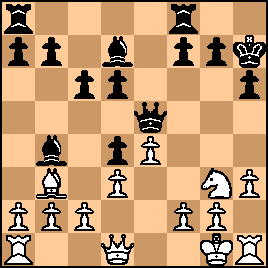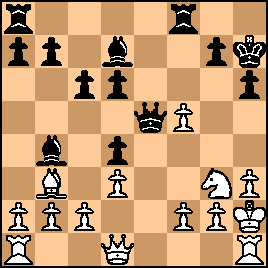KEG: Post II
12... d6
12...d5 or 12..Re8 were stronger, but at this stage it appears that Romanovsky was shunning any complications, satisfied with a draw that was at this stage of the tournament as good for him as a win. 13. Ng3
Somewhat more logical for White are 13. a3 or 13. b3 or 13. h3; especially against an opponent seemingly content with a draw. 13... Kh7
Consistent with his safety first policy, Romanovsky got his King off the potentially dangerous a2..g8 diagonal. 14. h3
The beginning of a plan by Zubarev to obtain a castled King's position the hard way (i.e., Kg2; Kh2 and then Rf1 or Re1. This plan, however, had a flaw that would soon become evident. 14... Bd7
15. Kg1 Qe5

click for larger viewWith the Black Queen on e5, Zubarev's idea of Kh2 en route to castling has hit a snag. But, nothing daunted, he soldiered on with: 16. Kh2?
He could likely have held his own with 16. Ne2 saving "castling" for later (possibly by means of g3 and Kg2). 16... f5!
Romanovsky took prompt advantage of Zubarev's temerity. White is now in serious trouble, if not theoretically lost already. 17. exf5
17. a3 was probably most prudent. After the text, Romanovsky almost certainly had victory in his grasp: 
click for larger view17... Rae8
Wimping out. Romanovsky should have followed his last strong move with 17...d5! 18. Rf1

click for larger view18... Rxf5
Too cute by half. The g3 Knight was pinned so this doesn't lose a Rook, but--especially in light of Romanovsky's tempo-losing next move, he should just have played 18...Bxf5 or perhaps 18...d5. 19. Kh1?
Still blinded by his "castling" plan, Zubarev missed 19, c3, which would have gotten him pretty much back into the game. 19... Rff8
Having played 18...Rxf5, and having gotten a lemon of a response by Zubarev, Romanovsky should surely have continued with 19...Rf4! But he was seemingly still fixed on making sure he didn't lose and allow Levenfish to catch him and tie for second prize. But now Zubarev got a bit cocky and, instead of playing something solid such as 20. c4 or 20. c3 or 20. a3, he decided to bring matters to a head with: 20. Qh5?

click for larger viewAll of a sudden, Romanovsky had a variety of ways to win. He could have traded Queens; he could have played 20...d5. But he chose another powerful move: 20... Qf4
I see no way for White to survive with best play from here. 21. a3 g6
22. Qd1 Ba5

click for larger viewWhether Black has a theoretical win at this point became moot, as Zubarev, perhaps out of desperation, began playing wild chess and was--as I will discuss in my next post on this game-- wiped out by Romanovsky in short order. | 




